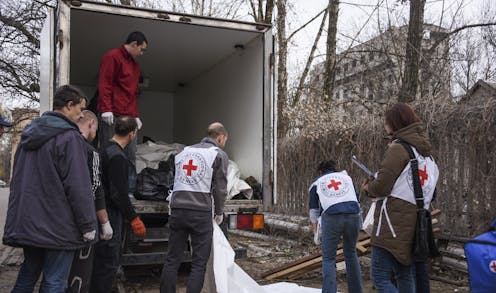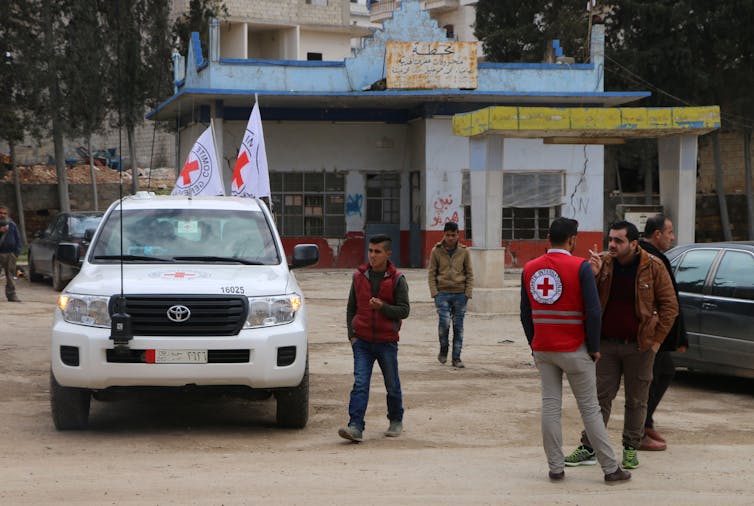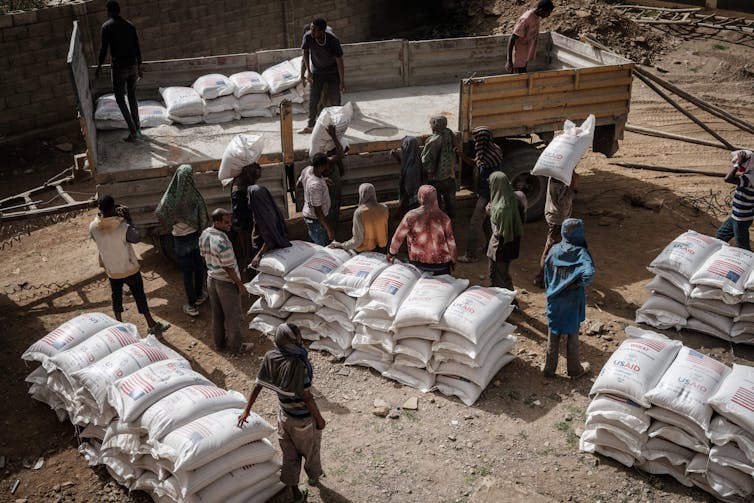Humanitarian aid workers need security, rights and better pay
Nearly all of the 129 aid workers killed on the job in 2021 were from the countries where they lost their lives.

Professional humanitarian aid workers in war-torn places like Ukraine, Ethiopia, Syria and South Sudan do some of the most dangerous jobs in the world.
You might imagine them as people who parachute into battlefields or places wrecked by disasters. However, the vast majority are local residents of countries and communities in crisis.
For the last 15 years, I have been conducting ethnographic research in several Ethiopian communities experiencing conflicts and other crises, including hundreds of detailed interviews and observations. As I explain in my recently published book on the politics and inequities of global humanitarian work, local aid workers around the world face two major challenges.
First, they are not just accidental casualties in conflicts. Instead, local aid workers are increasingly the strategic targets of attack for military forces. Second, despite the dangers inherent in their jobs – and compared with their international or expatriate colleagues working in cities and headquarters offices far from where crises unfold – they earn less money, have less job security and have far fewer benefits such as life insurance.

Aid work can be deadly
Almost 95% of the attacks on aid workers from 2010 to 2019 were on local or national staff. Only three of the total 129 aid workers who died on the job in 2021 were stationed in foreign countries. The rest were locals. The numbers of aid workers hurt or killed on duty continues to rise every year.
Ethiopia was the world’s deadliest country for aid workers in 2021. According to the Aid Worker Security Database, in which a humanitarian consulting firm tracks these deaths, a total of 19 aid workers from that country died in 2021. Three additional Ethiopian aid workers with Doctors Without Borders were attacked and killed by Ethiopian soldiers in January 2022.
One reason why local relief workers face so much danger is that targeting aid workers has become a key part of war strategies in Ethiopia, Syria and now also in Ukraine.
Attacks on people who provide assistance does not simply endanger the aid workers. It can terrorize and kill much larger numbers of people. Attacks on health care providers, for example, can rob thousands of patients of their life-saving medical care. Attacks on aid workers distributing food and water imperils thousands more.
The role of international law
Targeting aid workers violates International Humanitarian Law, a body of laws that govern the conduct of war.
After World War II, most countries, including Russia, Ethiopia, Syria and the United States, ratified the Geneva Conventions. These laws outline the responsibilities national governments have to protect the lives and dignity of both combatants and civilians during conflict.
The International Committee of the Red Cross, a global nongovernmental organization that drafted the Geneva Conventions, is tasked with defining and executing these laws, as well as providing additional forms of humanitarian assistance.
The Additional Protocol I, added to the Geneva Conventions in 1977, spells out specific responsibilities governments have to protect aid workers.
However, these international laws lack effective enforcement mechanisms. Without clear consequences or meaningful deterrence, I expect attacks on aid workers to continue to harm and kill humanitarian workers.
Equity and workers’ rights
Aid workers are beginning to demand changes, such as stronger job security, more legal recourse in labor cases that involve exploitation, injury or abuse, and more equitable compensation in light of the risks inherent in their profession.
Organizing and demanding these changes is a challenge, however. Humanitarian organizations are both geographically dispersed and diverse, with different types of employers such as nongovernmental, governmental and United Nations organizations all over the world.
Even so, aid agencies like Doctors without Borders, Oxfam and others are calling for more meaningful reforms. They are embracing the “localization” of aid – or making greater investments in locally led humanitarian action. Calls to “decolonize” aid by dismantling racist and discriminatory structures and norms rooted in colonialism and imperialism are also growing.
However, my research suggests that these reforms require additional attention to the way aid workers – especially local and national staff – are targeted in contemporary conflicts. Local aid workers also need stronger security, more consistent rights, and better and more equitable compensation and benefits across different countries and organizations.
Unprotected and undervalued
One afternoon in the Ethiopian city of Jigjiga, in August 2018, I interviewed the head of emergency programs at a U.N. relief agency’s local office. He was a Somali-Ethiopian man I call Farah to maintain his anonymity.
Recent conflicts had resulted in several attacks on convoys delivering food and teams of health workers.
When we met, Farah was frustrated. He had just been demoted and stripped of his leadership role despite his success managing teams of mobile health workers and a growing portfolio of emergency health programs. Vaccination rates had increased and rates of malnutrition had declined on his watch – even in communities beset by conflict, droughts, displacement and distrust in governmental authorities.
[You’re smart and curious about the world. So are The Conversation’s authors and editors. You can read us daily by subscribing to our newsletter.]
The U.N. had brought in an “international expert,” Farah said, to take his place. “The new guy had to learn everything, internally and externally, like the culture, the history, etc.”
“You have to introduce the new person to all the external partners,” he said, before taking out his cellphone and scrolling through hundreds of contacts. They ranged from local politicians to health workers to religious leaders in drought-hit villages hundreds of miles away.
“It’s your relationships with all these different people that is so important,” he continued. “You have to be able to react and help correct the new coordinator when they don’t understand something.” As my book details, Farah’s leadership, networks and experience had been key, so far, to keeping his teams safe.
Like Farah, local aid workers in Ethiopia are essential to making international relief operations work and to managing the risks aid work entails. But at the same time, Farah and others like him continue to lack job security as well as equitable compensation and adequate security. He was valued for his localness and his knowledge of Somalis, but not his additional transferable skills in leadership and diplomacy, as well as personnel, logistics and risk management. Farah’s contract ended the week after we met.

Most international humanitarian organizations like Doctors Without Borders and UNICEF have already agreed to uphold a set of professional standards for relief operations, such as how much water and food per person must be provided daily. Based on my research, I believe that standards for safety, security, monetary compensation and benefits for staff are necessary as well, and that these standards could be developed in a similar way.
Aid workers like Farah, and so many thousands of others who put their lives on the line every day, deserve better.
Lauren Carruth receives funding for her research from the National Science Foundation and the National Institutes of Health.
Read These Next
Getting peace right: Why justice needs to be baked into ceasefire agreements – including Ukraine’s
Just war theory, a centuries-old field of ethics, deals with how and when to start conflicts. It can…
Best way for employers to support employees with chronic mental illness is by offering flexibility
Employers that don’t support employees with mental illness risk missing out on the talents and skills…
From civil disobedience to networked whistleblowing: What national security truth-tellers reveal in
Whistleblowers’ stories show how accountability is shifting from formal legal institutions to solidarity…





